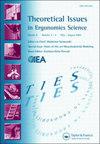Emergence and non-emergence for system safety
IF 1.4
Q4 ERGONOMICS
引用次数: 1
Abstract
Abstract Emergence has been proposed as an important construct for research on the safety of sociotechnical systems. There is, however, some dissension about the fundamental nature of emergence. Furthermore, there is little clarity on how this construct might be used within safety research to guide analysis or design of sociotechnical systems. Emergence has proven to be a challenging construct to pin down in disciplines such as philosophy and computer science. Most troubling is that the distinction between emergent and non-emergent phenomena remains unclear. Here we offer a pragmatic view by outlining models of different types of emergence. We subsequently argue that one type, functional–semantic emergence, bears on a crucial distinction between Safety I and Safety II as discussed within system safety research. We conclude that safety of sociotechnical systems can be enhanced by integrating retroactive control of non-emergent phenomena with proactive control of emergent phenomena where retroactive control is achieved through use of rules and procedures and proactive control is achieved through attention to subtle information and use of recognition-primed decisions. Practitioner Summary Emergence has recently been invoked as an important construct in the systems safety literature. There is, nevertheless, some dissension in that literature regarding the nature of emergence and there is little explanation of how it can inform an approach to system safety. Here we contrast different models of emergence as a means of clarifying the nature of emergence and non-emergence. From there, we argue that the contrast between emergence and non-emergence can inform the contrast between Safety I and Safety II approaches to system safety.系统安全的紧急和非紧急
涌现是研究社会技术系统安全性的重要概念。然而,关于涌现的基本性质存在一些分歧。此外,对于如何在安全研究中使用这种结构来指导社会技术系统的分析或设计,目前还不太清楚。事实证明,在哲学和计算机科学等学科中,“涌现”是一个具有挑战性的概念。最令人不安的是,紧急现象和非紧急现象之间的区别仍然不清楚。在这里,我们通过概述不同类型的涌现模型,提供了一种实用主义的观点。我们随后认为,一种类型,功能-语义涌现,与系统安全研究中讨论的安全I和安全II之间的关键区别有关。我们的结论是,社会技术系统的安全性可以通过将非紧急现象的追溯控制与紧急现象的主动控制相结合来增强,其中追溯控制通过使用规则和程序来实现,而主动控制通过关注微妙信息和使用识别启动决策来实现。最近在系统安全文献中,涌现被认为是一个重要的概念。然而,在这些文献中,关于涌现的本质存在一些分歧,并且几乎没有解释它如何为系统安全方法提供信息。在这里,我们对比了不同的涌现模型,作为澄清涌现和非涌现本质的一种手段。由此,我们认为紧急和非紧急之间的对比可以为系统安全的安全I和安全II方法之间的对比提供信息。
本文章由计算机程序翻译,如有差异,请以英文原文为准。
求助全文
约1分钟内获得全文
求助全文

 求助内容:
求助内容: 应助结果提醒方式:
应助结果提醒方式:


